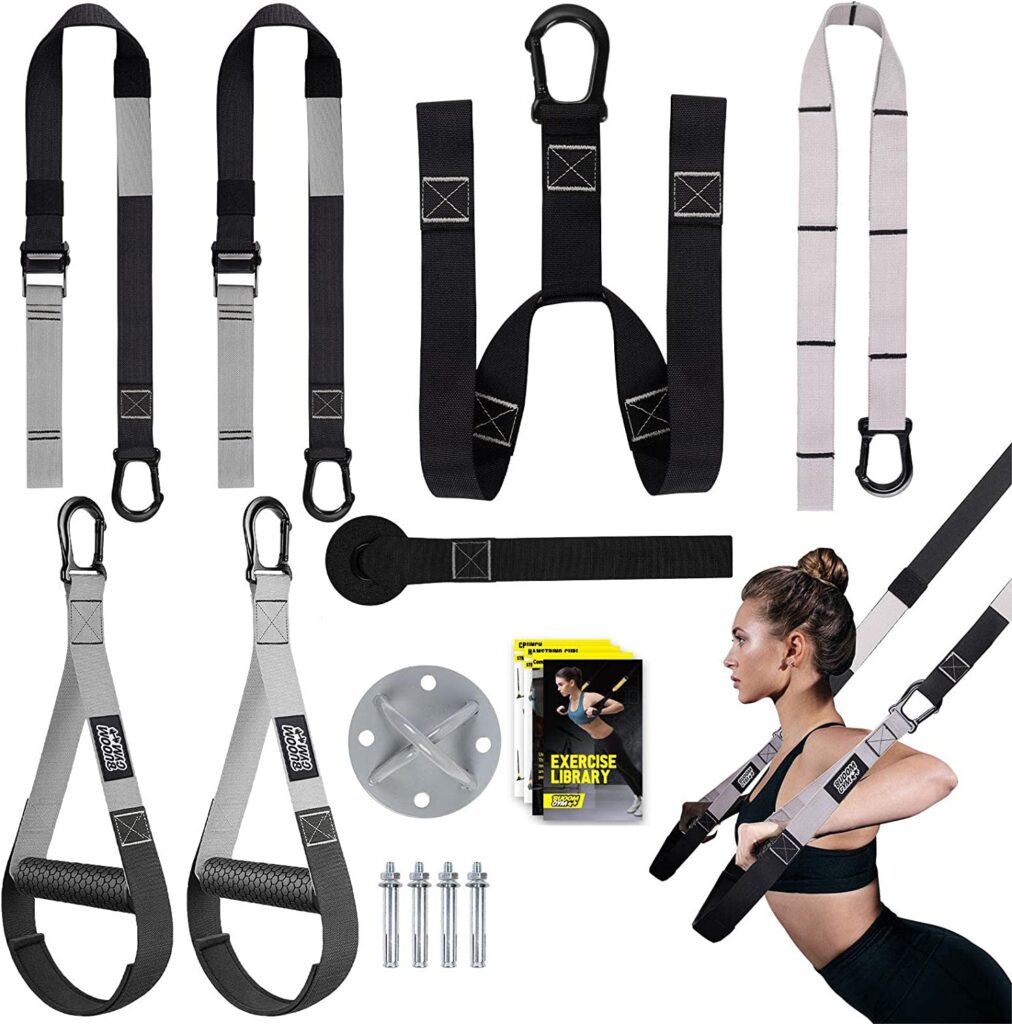A strong and stable back will help lower your chance of back pain and injury, which is a common complaint, particularly among those who sit for long periods of time.
Back exercises can help you battle the consequences of sitting while also improving your general functionality and posture. Here are some strength-based standing back exercises to make your back strong and stable while preventing injuries and pain.
This post contains referral links for products we love. Staying Fit With Aeran earns a small commission on these links at no cost to you, and the links will always be marked with an asterisk *.
Overview
You will need a barbell, dumbbells, suspension trainer, rack, resistance band, and sled for this program. There are several pieces of equipment and variants for each activity, but most people find that using a full gym is the best chance for doing this practice as-is.
Choose two to three of these standing back exercises to incorporate into your full-body or upper-body regimen, or do the complete workout as a back day routine.
If you opt to do the entire program, you will need to change your rep counts and sets to accommodate the increased number of exercises. The entire workout should last roughly 45 minutes, with 1 to 2-minute pauses between each set and activity.
Select two to three exercises and execute two to three sets of each if conducting the workout as part of a full-body or upper-body split. If you’re completing this workout as a back-day program, you’ll execute 1 set of pull-apart, 2 sets of pulldowns, 2 sets of suspension rows, and 2 sets of rack pull. Finish with one to two sets of sled pulls.
Prepare Yourself
Warm-up using dynamic movements that are similar to the exercises you will be doing during your workout. This will help your central nervous system activate, prepare you for the work ahead, and engage your muscles. Warm up with standing back exercises, including banded rows, wall angels, and arm circles.
The Exercise
The following workout consists of five specific standing-back exercises that will increase your stability, strength, and performance. The number of reps listed below is simply guidelines. Adapt the rep ranges to your skill level and preferences.

Remember that for tiny muscle groups, it is advisable to do more reps with a lower weight to ensure consistent form. Using bigger weights with larger muscle groups can ensure a good rep range before failure without exhausting yourself. Here’s how to perform each of the exercises in this program.
Banded Workout
Banded pull-parts are an ideal starting exercise for “back day” because they increase muscular activation and the mind-muscle link to the back, which many individuals struggle with. They also counteract the consequences of seated hunching, preparing you to keep an upright posture during your other workouts.
- Using an underhand grip, hold a resistance band at chest height.
- Pull the band apart at chest height, bringing it to your chest as you separate your hands.
- Once your hands are fully apart, squeeze your shoulder blades back and down.
- Maintain a tall stance with your ribs down (no hunching your shoulders).
- Slowly bring your hands together and release with control.
Rep until you’ve completed 15 to 20 reps.
Pullup with Straight Arms
Straight arm pulldowns are a standing-back workout that targets the lats and middle back while also activating the lower back. Use a cable machine or resistance bands that are attached to a doorframe or another permanent place.
- Stand with your feet shoulder-width apart, your lower back straight, and your core engaged.
- Using an overhand hold, grab a pulldown bar or resistance band handle.
- Keep your arms straight, with your elbows slightly bent, as you lower the bar to your hips or thighs.
- Throughout, exhale and engage your lats.
- Pause for a count, then return to the start with control, making sure the weight plates do not contact before starting another rep.
Rep until you’ve completed 15 to 20 reps.
Rows on a Suspension Trainer *
A suspension trainer can be used to perform a standing row. This workout will target your mid back with assistance from your abs, biceps, and shoulders. To get the most benefits out of this exercise, focus on pulling yourself up with your back muscles rather than your arms.
- Stand facing the anchored suspension trainer, straps above your head, and brace your lower back while activating your core.
- Lean back until your arms are straight to allow tension in the straps that are holding your weight.
- Using your back muscles, pull yourself up while maintaining your core engaged.
- Avoid allowing your back to arch, and avoid using your biceps.
- Contract your back muscles and then slowly reverse the motion.
Repeat for 10 to 15 reps total.
Rack Pulls
Rack pulls are similar to deadlifts in that you are pulling the bar from a racked position rather than off the floor, but they only contain the upper portion of the activity. This workout focuses on the lower back, increasing stability and strength in an area prone to tension and pain. For this action, use a hefty weight.
- Place a barbell at knee height in the rack.
- Bend your knees and bend your hips while raising your chest.
- Use an overhand or mixed grip to hold the barbell.
- Stand tall by pushing your hips forward and maintaining your back straight.
- Pause for a count before returning the bar to the rack with control, fully locking out your hips and squeezing your lower back and glutes.
Rep until you’ve completed 8 to 10 reps.
Sled Pulls
Sled pulls are a useful strength and power-building exercise that is commonly utilized in athletic training and is ideal for a back-day finisher.
Pulling motions are common in everyday life and represent a basic human movement.
Performing this exercise as part of a “back day” can help you eke out more volume and appropriately fatigue the back muscles to improve outcomes. To avoid back discomfort, maintain flawless form throughout.
- Load the sled with a heavy weight and stretch the rope straight out.
- Stand at the end of the rope with your feet slightly wider than shoulder-width apart.
- Squat down with your knees bent a little more than 90 degrees.
- Grasp the rope with your dominant arm extended out in front of you, almost completely extended.
- Engage your core and pull the rope toward your body with your forward, dominant arm while extending out your other arm to grasp and pull in a fluid movement.
- Pull the sled all the way before walking backward and restarting.
Pull for 30 to 60 seconds at a time.

Precautions and Safety
Before performing these standing back exercises, make sure you can do them correctly and that you’ve picked a weight that’s appropriate for your ability. If you’re not sure how to do them, consult with a personal trainer.
Don’t do any activity that aggravates your joints or muscles in an unnatural way. Aside from the natural muscle challenge that comes with strength training, you should not experience any pain or strain. Avoid standing back exercises if you have a current injury of any type unless you have been cleared by a healthcare specialist.
To Conclude
Back exercises are essential for developing a strong and stable core, maintaining a healthy spine, and lowering the risk of back injury and strain. Correcting bad posture patterns caused by sitting or hunching over all day is best addressed by incorporating back-strengthening activities through resistance training.
The standing back exercises mentioned above will help with this. Remember to consult your doctor before attempting new workouts and to receive clearance if you have back discomfort or an injury.

